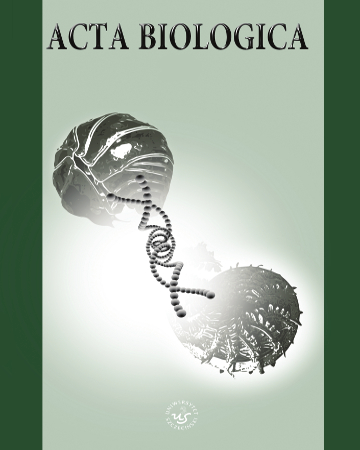
ISSN: 2450-8330
OAI
DOI: 10.18276/ab.2017.24-03



Issue archive /
No. 24
Preliminary data on the epigeic beetle fauna (Coleoptera) of the Golczewskie Uroczysko Nature Reserve
| Authors: |
Brygida
Radawiec
Institute of Biology and Environment protection of Pomeranian University Łukasz Baran University of Szczecin, Department of Invertebrate Zoology and Limnology, Institute for Research on Biodiversity, Faculty of Biology Przemysław Śmietana University of Szczecin, Deparment of Ecology & Environmental Protection, Institute for Research on Biodiversity, Faculty of Biology Ewa Sarnacka University of Szczecin, Department of Invertebrate Zoology and Limnology, Institute for Research on Biodiversity, Faculty of Biology Andrzej Zawal University of Szczecin, Department of Invertebrate Zoology and Limnology, Institute for Research on Biodiversity, Faculty of Biology |
| Keywords: | epigeic beetles Coleoptera: Catopidae Carabidae Elateridae Geotrupidae Silphidae Staphylinidae Tenebrionidae Golczewskie Uroczysko Nature Reserve West Polish Pomeranian |
| Data publikacji całości: | 2017 |
| Page range: | 9 (19-27) |
Abstract
A study was conducted in May–August 2006 in the Golczewskie Uroczysko Nature Reserve,
UTM WV06, using 10 Barber traps containing ethylene glycol. A total of 2,141 beetles were
collected, belonging to 58 species from 7 families. The epigeic beetle fauna of the reserve
comprised mainly forest, grassland and peatland species. Stable populations of three ground
beetle species under partial protection, Carabus convexus, Carabus coriaceus and Carabus
glabratus, are present in the forest habitats. The most ecologically valuable species include
hygrophilous peatland species: Agonum ericeti (VU), Pterostichus rhaeticus, Agonum hypocrita,
Limodromus krynickii, Oodes helopioides (VU), and the rare click beetle Paraphotistus
impressus, all of which have poorly known ecological preferences.
Download file
Article file
Bibliography
| 1. | Aleksandrovich, O.R. (2004). List of species. Wykaz gatunków – Coleoptera: Carabidae. In: W. Bogda¬nowicz, E. Chudzicka, I. Pilipiuk, E. Skibińska (eds.), Fauna Polski – charakterystyka i wykaz gatunków (1, pp. 32–42). Warszawa: MiIZ PAN. |
| 2. | Aleksandrowicz, O. (2014). Ground beetles (Coleoptera, Carabidae) west of the forest zone of the Russian Plain. Fauna, zoogeography, ecology, faunogenesis. Saarbrücken: Lambert Academic Publishing. |
| 3. | Aleksandrowicz, O.R., Browarski, B., Stachowiak, M. (2017). Ground beetles (Coleoptera, Carabidae) of the marsh complex “Torfiaki” (Mazuian Lakeland). In: OV Yanchurevich et al. (eds.), Zoological readings – 2017: Proceeding of the International Scientific and Practical Conference (Grodno, March 15–17, 2017), (pp. 11–19). Grodno [in russian]. |
| 4. | Burakowski, B., Mroczkowski, M., Stefańska, J. (1974). Chrząszcze – Coleoptera. Biegaczowate – Carabidae 2. Katalog Fauny Polski. Cz. 23, t. 3. Warszawa: PWN. |
| 5. | Burakowski, B., Mroczkowski, M., Stefańska, J. (1985). Chrząszcze – Coleoptera. Buprestoidea, Elateroidea i Cantharoidea. Katalog Fauny Polski. T. 23, z. 10. Warszawa: PWN. |
| 6. | Council Directive 92/43/EEC of 21 May 1992 on the conservation of natural habitats and of wild fauna and flora – Natura 2000. |
| 7. | Främbs, H., Dormann, W., Mossakowski, D. (2002). Spatial distribution of carabid beetles on Zehlau Bog. Baltic J. Coleopterol., 1 (2), 7–13. |
| 8. | Ilnicki, P. (2002). Torfowiska i torf. Poznań: Wydawnictwo AR w Poznaniu. |
| 9. | Koch, K. (1989). Die Käfer Mitteleuropas. Ökologie. Krefeld: Goecke & Evers Verlag. |
| 10. | Kondracki, J. (2004). Geografia Fizyczna Polski. Warszawa: PWN. |
| 11. | Krogerus, R. (1960). Ökologische Studien über nordischer Moorarthropoden. Artendbestand, ökologische Faktoren, Korrelation der Arten. Commentat. Biol., 3 (21), 238. |
| 12. | Kuśka, A. (1995). Omomiłki (Coleoptera, Cantharidae): Cantharinae i Silinae Polski. Monografie Fauny Polski. T. 21. Warszawa: PWN.Preliminary data on the epigeic beetle fauna (Coleoptera) of the Golczewskie Uroczysko Nature Reserve 27 |
| 13. | Mossakowski, D. (1970). Ökologische Untersuchungen an epigäischen Coleopteren atlantischer Moor- und Heidestandorte. Z. Wiss. Zool., 1–2 (181), 233–316. |
| 14. | Mossakowski, D., Främbs, H., Lakomy, W. (2003). The Carabid and Staphylinid fauna of raised bogs. A comparison of Northwest Germany and the Baltic region. Baltic J. Coleopterol., 2 (3), 137–144. |
| 15. | Pawłowski, J., Kubisz, D., Mazur, M. (2002). Coleoptera Chrząszcze. Czerwona lista zwierząt ginących i zagrożonych w Polsce. In: Z. Głowaciński (ed.), Red list of threatened animals in Poland. Polish Academy of. Sciences, institute of Nature Conservation PAS (pp. 88–110). Kraków: Polska Akademia Nauk, Instytut Ochrony Przyrody. |
| 16. | Peus, F. (1928). Beitrage zur Kenntnis der Tierwelt nordwestdeutscher Hochmoore. Eine ökologische Studie. Insekten, Spinnentiere (teilw.). Wirbeltiere. Z. Morphol. Ökol. Tiere, 12, 533–683. |
| 17. | Peus, F. (1932). Die Tierwelt der Moore unter besonderer Berücksishtigung der europaischen Hochmoore. Hendbuch der Moorkunde III. Berlin. |
| 18. | Renkonen, O. (1938). Statistisch-ökologische Untersuchungen über die terrestrische Käferwelt der finnischen Bruchmoore. Ann. Zool. Soc. Zool,-Boot. Fennicae, 1 (6). |
| 19. | Roubal, J. (1934). Die Coleopterenwelt (Thyrphobionte, Tyrphophile, Tyrphoxene etc.) der Treboner (Wittingauer) Moore. Folia Zool. Hydrobiol., 7, 56–97. |
| 20. | Sjörs, H. (1983). Mires of Sweden. In: A.J.P. Gore (ed.), Ecosystems of the world Vol. 4B. Mires: swamp, bog, fen, moor. Regional studies. Amsterdam–Oxford–New York: Elsevier Scientific Publishing Company. |
| 21. | Skwarra, E. (1929). Die Käferfauna des Zehlaubruches (Beitr. Zur Fauna des Zehlau-Hochmoores in Ostpreussen, VI). Schriften der Königlichen Physikalisch-Ökonomischen Gesellschaft zu Königsberg, 2 (66), 181–274. |
| 22. | Sushko, G.G. (2006). Fauna and ecology of Coleoptera (Ectognatha, Coleoptera) of the raised peat-bog of the Byelorussian Poozerye. Vitebsk: VSU them. PM Masherov. |
| 23. | Tews, J., Brose, U., Grimm, V., Tielbörger, K., Wichmann, M.C., Schwager, M., Jeltsche, F. (2004). Animal species diversity driven by habitat heterogeneity/diversity: the importance of keystone structures. J. of Biogeography, 31, 79–92. |
| 24. | Thiele, H.U. (1977). Carabid beetles in their environments. A Study on Habitat Selection by Adaptation in Physiology and Behaviour. Berlin–Heidelberg–New York: Springer–Verlag. |
| 25. | Żurek S. (1987). Złoża torfowe Polski na tle stref torfowych Europy. Dokumentacja Geograficzna, 4. |